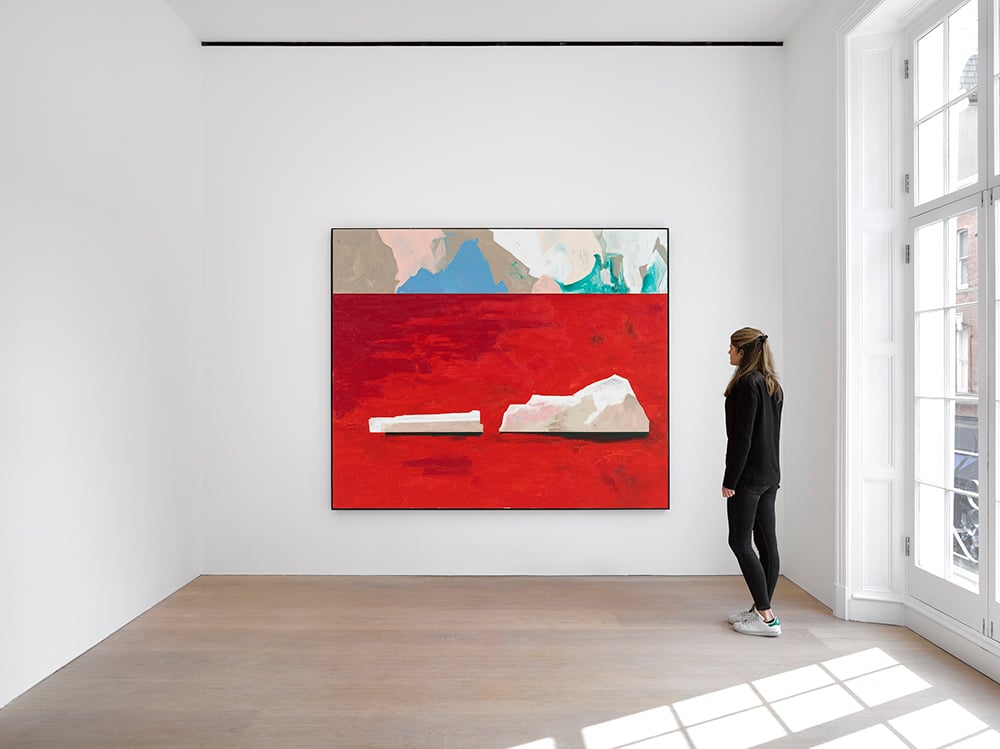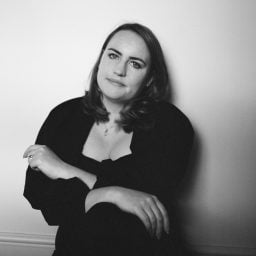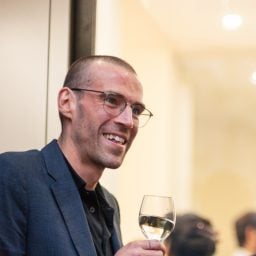For his first solo show in the UK, the Belgian artist Harold Ancart has landed a whale. I meet the 38-year-old painter at David Zwirner’s London space, where he is inaugurating his first show at the behemoth gallery. “It is a great honor,” he tells me breathlessly, as if he can’t quite believe where he’s standing. “David Zwirner’s program is probably one of the best in the world.”
Ancart has had a winding path to art-world success. Several times, he almost gave up on his work entirely due to poverty and lack of recognition. But now, as his star is rapidly rising, he says it was all worth it, even just for the look of pride on his mother’s face at his first big opening in London. (A stalwart supporter, she comes to all of his shows, and is currently beaming from the sidelines at the tony Grafton Street gallery.)
The show, aptly titled “Freeze,” is full of colorful abstract paintings of icebergs that conjure thoughts of rapidly melting glaciers. (Asked whether climate change concerns him, he answers rhetorically, “Doesn’t climate change concern every one of us?”) Each painting includes a bleak horizon line that Ancart says serves to make the work feel rooted in the history of Western art and to project the viewer into the future. “Without a horizon line, one gets lost and eventually dies,” he says.
A Brussels Sprout
Born in Belgium in 1980, Ancart started drawing in elementary school. “I remember that a tall redhead guy with glasses named Mr. Antoine gave me gouache to paint with,” he recalls of his artistic debut. “Since then I never really stopped.”
Drawing was a reliable pastime for Ancart, who recognized it as “a great way to escape the boredom of being at school without getting into trouble.” He also voraciously read comic books and manga growing up in Brussels, a city where comics are close to the hearts of many. As a young boy, he was inspired by the Belgian creator of Tintin, Hergé, as well as the work of Peyo (the creator of the Smurfs). Ancart would doodle his comic book heroes on every scrap of paper he could find.
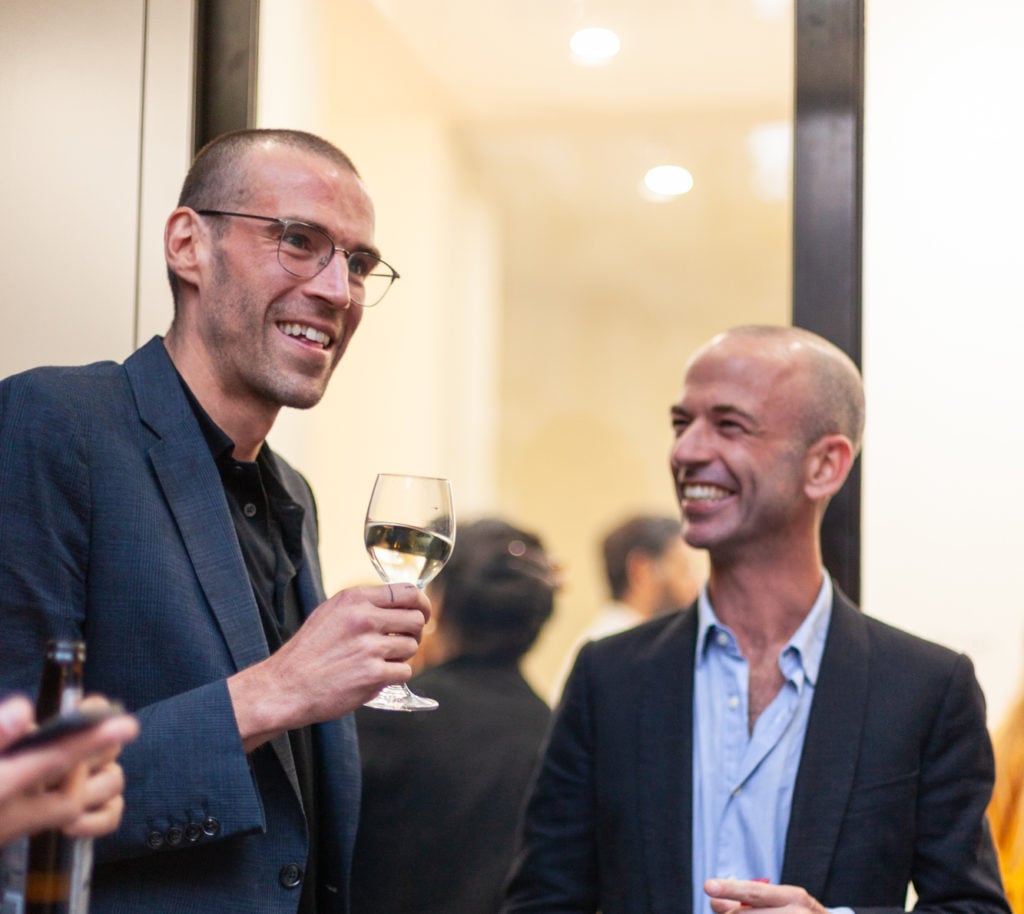
Harold Ancart, left, at the opening of “Freeze” (2018). Photo by Justyna Fedec courtesy David Zwirner.
Later, he moved on to more highbrow comic creators, including Jean Van Hamme and Yves Swolfs, who he still reads today. “I like the fact that this medium has the ability to open unthinkable universes by means that are really simple,” Ancart explains. “An outline combined with some color and text is enough to make you travel far away.” As he grew, his artistic tastes expanded to accommodate other draftsmen, including the Belgian artists Léon Spilliaert and James Ensor, as well as Egon Schiele, Oskar Kokoschka, and Frank Auerbach.
Despite his intense interest, Ancart says he never really saw himself becoming a professional artist. “I guess I never liked the bohemian vibe that surrounded the persona of the artist,” he explains, free-associating the likes of “bread crumbs, stinky cheese, cheap red wine, poverty,” and, of course, that hallmark of artistic life: “struggle.” So after graduating from high school when he was 20 (he was held back twice for poor grades, math presenting a particular hurdle), Ancart went on to study political science at university, hoping to become a diplomat.
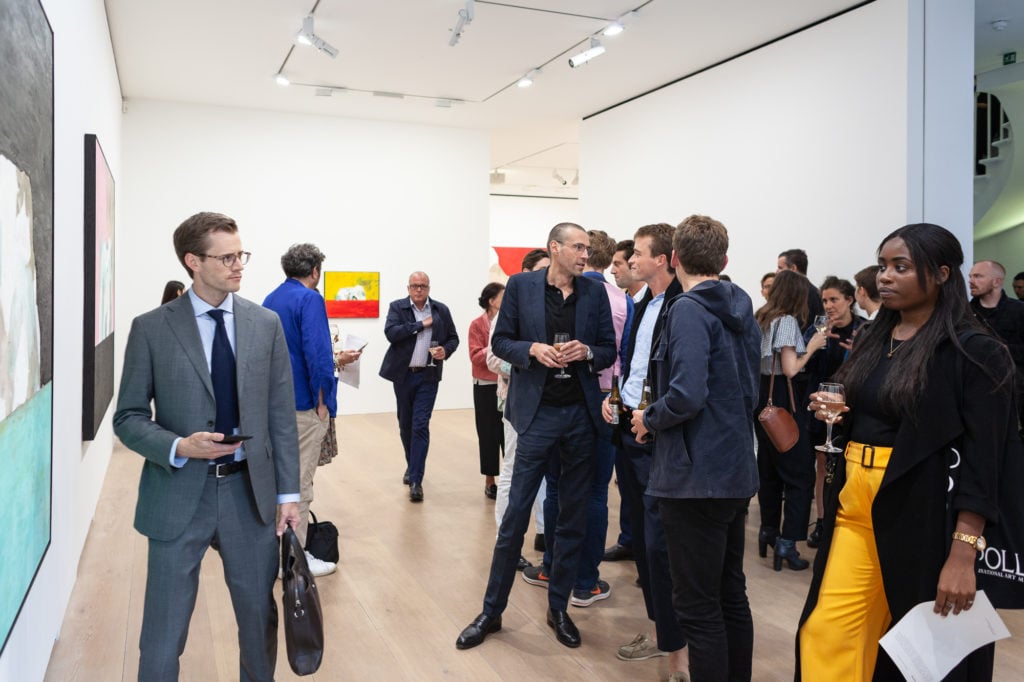
The opening of Harold Ancart, “Freeze” (2018). Photo by Justyna Fedec courtesy David Zwirner.
“It did not work out at all,” he confesses. So he decided finally to embrace his calling as an artist, attending the École Nationale Supérieure des Arts Visuel de la Cambre in Brussels to study fine arts. While he was underwhelmed by Warhol when he visited an exhibition at age 16—“everything was printed, and the absence of a hand was bothering me,” he explains—the school opened his mind to art in an age of mechanical reproduction.
His focus on drawing continued in the ensuing years, although he began to experiment with other methods of artistic creation, too. In his second year, he read the writings of Donald Judd, and shortly thereafter, turned toward abstraction and minimalism in his own work, drawing on a variety of inspirations ranging from Kazimir Malevich to Ellsworth Kelly to African and Aboriginal patterns.
Road Trip
After graduating from college with an MFA in 2007, then-27-year-old Ancart began life as a professional artist. As many artists quickly learn, networks are key. He became the first artist represented by Brussels’s CLEARING, a now highly regarded gallery, through a handshake deal with its founder, his friend Olivier Babin. Babin was also an artist, but sensed he would be unable to compete at the highest levels and decided to get into the gallery game instead. “He said that he would prefer to be a good trainer rather than a bad player,” says Ancart.
Although Brussels is now a tight-knit art-world hub, there wasn’t much going on in the city at the time. “After all these years having been told that painting was dead and that sculpture was dead too, it was either getting a teaching position at some academy where you could teach old ladies how to paint ducks and dogs in watercolor in the evening, or unemployment,” Ancart explains. “I wanted to try something else.”
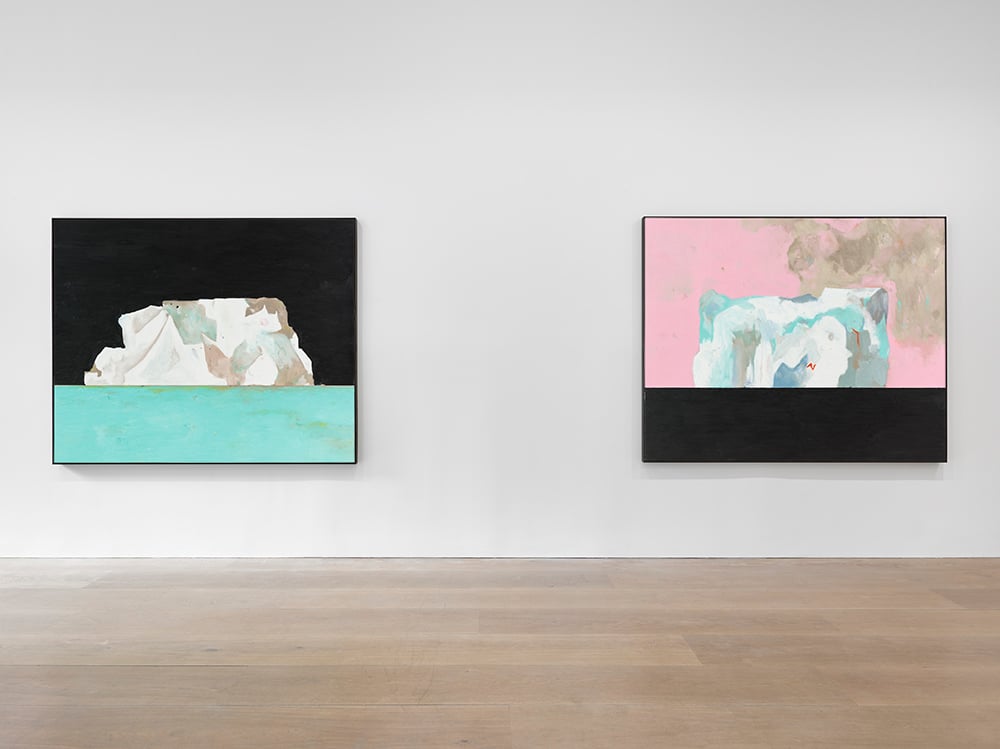
Harold Ancart, installation “Freeze” (2018). Photo courtesy David Zwirner.
So he moved to New York, where his love affair with comic art continued as he devoured English-language comics like Frank Miller’s Sin City. At the same time, his career blossomed steadily. He eventually secured additional representation at Xavier Hufkens and the Los Angeles-based David Kordansky Gallery.
Things really began to take off following an ambitious trans-American road trip he took in 2014. He transformed the trunk of his jeep into a makeshift studio for the epic trip and pulled over anytime he saw something that moved him to draw.
Mike Homer, a partner at David Kordansky, recalls a supercharged Ancart bursting into the gallery on the tail end of this trip and dragging everyone down to his car to take a look at the new work. Homer was impressed, but by the time he later visited Ancart in his New York studio and offered to buy one of the oil stick drawings, it was too late.
Ancart had already shown them to David Breslin, then-chief curator at the Menil Drawing Institute in Houston, who advised him to keep the series together, with the understanding that he might be able to find a place for them. In 2016, Breslin made good on his promise, and all 27 works ended up in the prestigious collection. Ancart has no doubt that the exhibition of these works that summer, “There Is No There There,” his first show at a major US institution, was a turning point in his career.
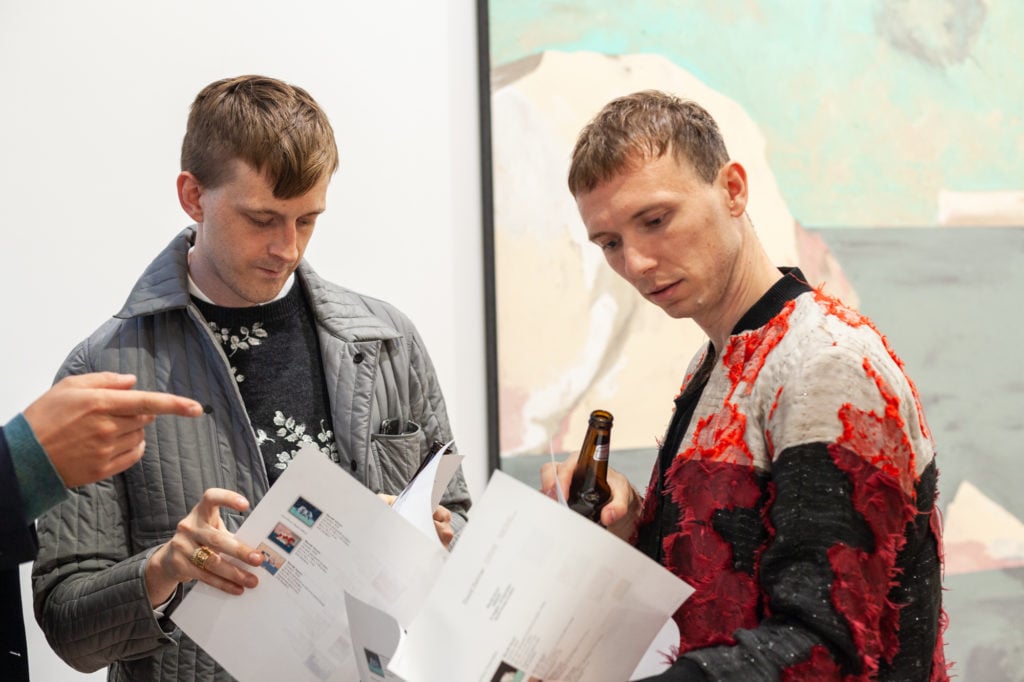
The opening of Harold Ancart, “Freeze” (2018). Photo by Justyna Fedec courtesy David Zwirner.
Speaking to artnet News about the show, Breslin says it was “obvious” when he saw the works in Ancart’s studio that they were meant to stay together. He felt they immediately connected to the long tradition of the American Sublime, which celebrates the range and splendor of the American landscape.
Later that year, Ancart’s secondary market hit an all-time high, when an untitled triptych from 2014 shattered its high estimate of $120,000 at Christie’s New York to make $751,500 with premium. His work has been consistently selling well above estimate since, according to artnet’s Price Database.
His primary market has also developed considerable buzz. His work is now in the collections of the Solomon R. Guggenheim Museum in New York, the Museum of Contemporary Art in Los Angeles, DC’s Hirshhorn Museum, Paris’s Fondation Louis Vuitton, and the Beyeler Foundation in Basel, among others. At Art Basel this year, David Kordansky had no problem selling an Ancart work for $110,000, and at Independent New York, CLEARING’s stand of Ancart’s new sculptures drew a crowd and quickly sold out.
Entering the Zwirner Fold
Ancart was brought into the Zwirner fold by Harry Scrymgeour, a former CLEARING partner who became a director of the gallery’s London space in March. At the opening of “Freeze,” Scrymgeour tells me he felt Ancart would be a good fit for Zwirner, a champion of painting. And he saw room for the show in an experimental period of the gallery’s calendar between the end-of-summer lull and before the heady excitement of Frieze London.
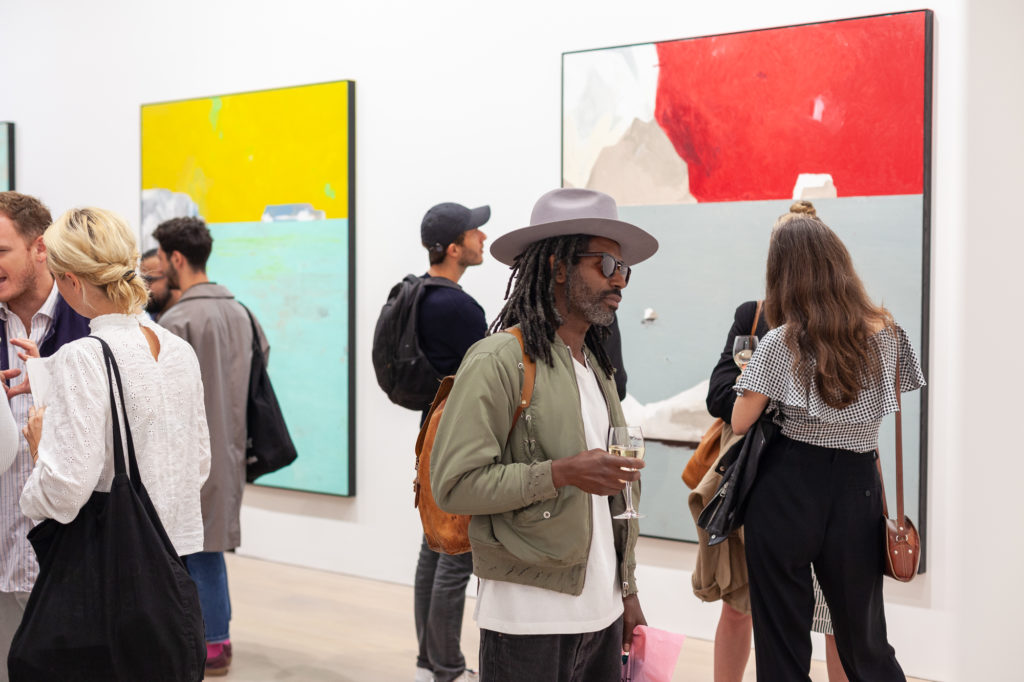
The opening of Harold Ancart, “Freeze” (2018). Photo by Justyna Fedec courtesy David Zwirner.
The presentation was put together in just three months. Zwirner has already received a lot of interest (there was talk among art consultants at the opening of a waiting list hundreds of names long). Collectors Marlene Taschen, Susanne and Lawrence van Hagen, and Theo Danjuma were among those spotted eyeing the work.
Next up, in October, Ancart is unveiling an ambitious site-specific installation at the Centre Pompidou-Metz in France. He’s creating a 50-foot by 16-foot painting for the massive picture window above the entrance to the art center, which will be lit up at night. Although his work has been compared in scale to the Mexican muralists before, he says if it weren’t for the window, he’d never have had the vanity to suggest making a work so enormous.
In 2019, he will return to New York for project that’s fitting for an artist who has been so successful in the art-world game of late. He tells artnet News he is working with the Public Art Fund on a major painted and sculptural handball court installation in a location still to be confirmed by the organization.
Harold Ancart’s “Freeze” is on view through September 22, 2018, at David Zwirner, 24 Grafton Street, London.
